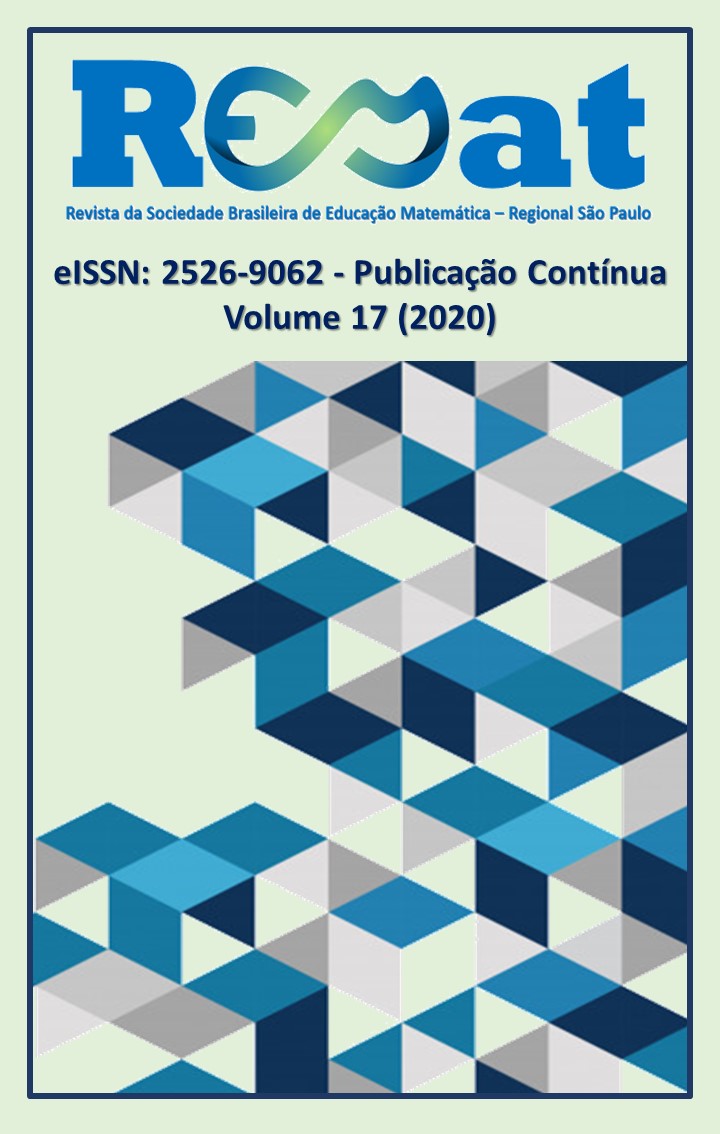The Problem Solving for Licenciate degree students in Mathematics: from Higher Education to Basic Education Classes
DOI:
10.37001/remat25269062v17id269Keywords:
Future Mathematics Teachers, Problem Solving, Activities GuidelinesAbstract
In this article, a work proposal is presented, which sought to help future Mathematics teachers to think about classes based on the Teaching-Learning-Evaluation Methodology of Mathematics through Problem Solving (ALLEVATO; ONUCHIC, 2009; 2014; ONUCHIC, 1999; ONUCHIC; ALLEVATO, 2004; 2011). Such proposal emerges as a result of the practices and doctoral research of Zanon (2019). This researcher’s study was developed in 2019/1 with 40 students enrolled in the "Problem Solving" subject in the first semester of the Mathematics undergraduate course at the Instituto Federal do Espírito Santo (IFES), Campus Cachoeiro de Itapemirim. It is a qualitative investigation (FIORENTINI; LORENZATO, 2007) that understands the investigative activity as a power to the pedagogical practice of teachers in initial training. Thus, it proposes, through Problem Solving as a methodological perspective, possibilities for teaching Mathematics in undergraduate courses with a view to its applicability in the performance of Basic Education teachers. Basides that, this investigation uses the Activities Guidelines proposed by Onuchic and Allevato (2011) so that undergraduate students in Mathematics can appropriate ideas that allow them to use the Teaching-Learning-Assessment Methodology of Mathematics through Problem Solving in the classroom, when in teaching practice, as a way of translating the theoretical studies developed at the university into practice.
Downloads
Metrics
References
ALLEVATO, N. S. G. Associando o computador à resolução de problemas fechados: análise de uma experiência. Rio Claro: Universidade Estadual Paulista, 2005. 370 f. (Tese). Disponível em: <https://repositorio.unesp.br/bitstream/handle/11449/102164/allevato_nsg_dr_rcla.pdf?sequence=1&isAllowed=y>. Acesso em: 23 mar. 2020.
ALLEVATO, N. S. G.; ONUCHIC, L. de la R. Ensino-aprendizagem-avaliação em Matemática: por que através da Resolução de Problemas? In: L. de La R., ONUCHIC; N. S. G., ALLEVATO; F. C. H., NOGUTI; A. M., JUSTULIN. (Org.). Resolução de problemas: teoria e prática. Jundiaí, Paco Editorial: 2014, p. 35-52.
_______. Ensinando Matemática na sala de aula através da Resolução de Problemas. Boletim GEPEM, n. 55, p. 133-154, jul./dez. 2009.
BRASIL. Ministério da Educação. Base nacional comum curricular. Brasília: MEC/CONSED/UNDIME, 2017.
_______. Parâmetros curriculares nacionais: Matemática. Ministério da Educação, Secretaria de Educação Fundamental. Brasília: MEC/SEF, 1997.
_______. Parâmetros curriculares nacionais: Matemática. Ministério da Educação, Secretaria de Educação Fundamental. Brasília: MEC/SEF, 1998.
BROLEZZI, A. C. Criatividade e resolução de problemas. São Paulo: Editora Livraria da Física, 2013.
FIORENTINI, D.; LORENZATO, S. Investigação em educação matemática: percursos teóricos e metodológicos. 2. ed. rev. Campinas, SP: Autores Associados, 2007.
ITACARAMBI, R. R. Resolução de problemas: construção de uma metodologia. São Paulo: Editora Livraria da Física, 2010.
MORAIS, R. dos S.; ONUCHIC, L. de la R. Uma abordagem histórica da Resolução de Problemas. In: L. de La R., ONUCHIC; N. S. G., ALLEVATO; F. C. H., NOGUTI; A. M., JUSTULIN. (Org.). Resolução de problemas: teoria e prática. Jundiaí, Paco Editorial: 2014, p. 17-34.
ONUCHIC, L. de la R. Ensino-aprendizagem de Matemática através da Resolução de Problemas. In: M. A. V., BICUDO. (Org.). Pesquisa em educação matemática: concepções e perspectivas. São Paulo: UNESP, 1999, p. 199-218.
ONUCHIC, L. de la R.; ALLEVATO, N. S. G. Pesquisa em resolução de problemas: caminhos, avanços e novas perspectivas. Bolema, v. 25, n. 41, p. 71-98, dez. 2011.
_______. Novas reflexões sobre o ensino-aprendizagem de matemática através da resolução de problemas. In: M. A. V., BICUDO; M. de C.; BORBA. (Org.). Educação matemática: pesquisa em movimento. São Paulo: Cortez, 2004, p. 213-231.
POLYA, G. How to solve it: a new aspect of mathematical method. 2. ed. New Jersey: Princeton University Press, 1973.
SANTOS, V. M. P. Avaliação de aprendizagem e raciocínio em matemática: métodos alternativos. Rio de Janeiro: Projeto Fundão, Instituto de Matemática da Universidade Federal do Rio de Janeiro, 1997.
SANTOS-WAGNER, V. M. P. dos. Resolução de Problemas em Matemática: uma abordagem no processo educativo. Boletim GEPEM, n. 53, p. 43-74, jul./dez. 2008.
SCHROEDER, T. L.; LESTER, JR, F. K. Developing understanding in mathematics via problem solving. In: P. R., TRAFTON; A. P., SHULTE. (Eds.). New directions for elementary school mathematics. Reston: NCTM, 1989. p. 31-42.
STAKE, R. E. Pesquisa qualitativa: estudando como as coisas funcionam. Porto Alegre: Penso, 2011.
STEIN, M. K.; ENGLE, R. A.; SMITH, M. S.; HUGHES, E. K. Orchestrating productive mathematical discussions: five practices for helping teachers move beyond show and tell, Mathematical thinking and learning, v. 10, n. 4, p. 313-340, 2008.
VAN DE WALLE, J. A. Matemática no ensino fundamental: formação de professores e aplicação em sala de aula. 6. ed. Porto Alegre: Artmed, 2009.
ZANON, T. X. D. Imagens conceituais de combinatória no ensino superior de matemática. Vitória: Programa de Pós-Graduação em Educação, Universidade Federal do Espírito Santo, 2019. 333 f. (Tese). Disponível em: <http://portais4.ufes.br/posgrad/teses/tese_13491_TESE%20Thiarla%20-%20%20FINAL%2001-05%20para%20IMPRESS%C3O.pdf>. Acesso em: 23 mar. 2020.
_______. Formação continuada de professores que ensinam matemática: o que pensam e sentem sobre ensino, aprendizagem e avaliação. Vitória: Programa de Pós-Graduação em Educação, Universidade Federal do Espírito Santo, 2011. 300 f. (Dissertação). Disponível em: <http://repositorio.ufes.br/bitstream/10/2278/1/tese_5183_THIARLA%20XAVIER%20DAL-CIN%20ZANON.pdf>. Acesso em: 23 mar. 2020.
Downloads
Published
Métricas
Visualizações do artigo: 260 PDF (Português (Brasil)) downloads: 69
How to Cite
Issue
Section
License

This work is licensed under a Creative Commons Attribution-NonCommercial-NoDerivatives 4.0 International License.


 Português (Brasil)
Português (Brasil)
 Español (España)
Español (España)
 English
English






































